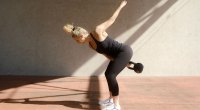Over the last decade, kettlebell training has become increasingly popular, making its way into bootcamps and CrossFit classes across the globe. Yet somehow, the full-body conditioning tool is often overlooked and underutilized in regular fitness routines.
As an effective strength training alternative to dumbbells and barbells, the kettlebell is a fantastic way to shape up and strengthen your body from head to toe. By its design, the dome-shaped iron weight can be used to boost strength and power development, build core strength and stability, and increase endurance. All while beating boredom and blasting plateaus.
The reason behind kettlebells’ effectiveness? “Kettlebell training combines explosive strength with muscular endurance to provide efficient and athletic training,” says Sarah Gawron, a New York City-based strength coach ONNIT-certified kettlebell flow expert, and founder of Kettlebell Strong, based out of Solace NYC.
Gawron, aka “Coach Sarah,” who is also certified with CrossFit L2, USA Weightlifting L2, and Kettlebell Athletic, is here to smash the myths surrounding kettlebell training while providing all the reasons you should be adding kettlebells to your regularly scheduled training routine.
Coach Sarah Debunks Common Kettlebell Myths
If you’re one of many gymgoers still reluctant to commit to kettlebell training for fear of injury or just uneasiness regarding the training tool’s technique and benefits, Gawron says don’t let these common kettlebell misconceptions. Knowing kettlebell truth from fiction is the first step toward making additional gains to your training.
1. A person can’t to gain strength with kettlebells
- Truth: “Building strength and size can be done in many different ways, and depends on numerous factors such as genetics, diet, training program, body type,” Gawron says. Case in point – Yes, kettlebells can build strength, but the end result comes down to how you train, how/what you eat, your genetics, lifestyle (and more) that create an environment for growth (or lack thereof).
2. Kettlebells can cause back issues.
- Truth: “Using kettlebells takes technique and skill development; Therefore, many people don’t use them because they think they will get hurt and end up bruised,” Gawron explains. If you are new to using kettlebells, she encourages working with a trainer and taking an online course or class that goes over the fundamentals. This will ensure proper technique and safety.
3. There is only one way to lift and use kettlebells.
- Truth: Short answer: FALSE! “There are many ways, styles, and schools of kettlebell training,” Gawron says. “All will confirm and encourage the movements should be done efficiently and pain-free.” She explains.
“Some people get confused by seeing hardstyle, Kettlebell Sport, or some hybrid of the two and want to know which style is ‘correct,” she says. But since movement can take so many different forms, there is no “wrong” way to move.
The Difference Between Kettlebells Training and Dumbbells
Although both kettlebells and dumbbells do a body good, there happens to be a surprising difference between the two.
Interestingly, the design of the kettlebell allows for a fuller and greater range of motion when training. “For example, the strict press, (when using a kettlebell), you can use the full range of the shoulder joint,” Gawron says. “When using a dumbbell or barbell, because of their design, the movement is shortened.”
Unlike barbells or dumbbells, kettlebell exercises allow the body to train different planes, where movements executed with a dumbbell and barbell are typically done in just the sagittal plane), recruit stabilizer muscles more, therefore making joints stronger, and require the body to evenly generate force in order to execute movements efficiently.
“The design of the kettlebell makes it unique and different compared to conventional tools like dumbbells,” Gawron says. “A kettlebell’s center of gravity is offset from its handle—it rests several inches away, requiring the stabilizer muscles to engage more to balance the weight during a movement,” she says, giving you more bang for your buck when pumping iron.

The Benefits of Kettlebell Training
Get ready to add kettlebells to your sweat sessions as they have proven themselves to be an excellent tool for total body conditioning. “Kettlebell training is a fine balance of improving mobility, building stability through joints, increasing muscle, and developing power,” Gawron says.
The conventional and traditional movements of kettlebell training such as the swing, clean, and snatch are all power and strength movements. “It is important to have such power movements in your training to help develop stronger, more resilient connective tissue; specifically, tendons, ligaments, fascia, and joint capsules,” she explains.
Kettlebell training also develops grip strength and helps aid in improving coordination and mobility. And of course, kettlebells crush the core as well.
“You can use kettlebells in a variety of ways: circuits, flow, strengthen exercises to build strength and improve cardiovascularly,” Gawron says. And you can train anywhere; the beach, a park, in the comfort of your own home, or your local gym!
Top Kettlebell Brands to Get You Started
You don’t need to invest much to get started in Kettlebell training. In fact, a person can accomplish a lot with a light, medium, and heavyweight. Here are Coach Sarah’s top three favorite Kettlebell Brands for you to choose from:
Keep in mind: Each company’s kettlebell mold is slightly different. One brand might have a long or thicker handle and the kettlebell will sit differently in the rack position. Consulting with a kettlebell instructor or professional will help take the guesswork out of what kettlebell works best for you.
Go with the Flow
Oftentimes, people may get intimidated by kettlebell terminology, one of those being a flow. A flow, according to Gawron, is like a dance, a combination of one move, say, a kettlebell swing, leading into another, like a clean, and continuing in what looks like a choreographed routine. It’s almost like a zen-like state with a kettlebell, and before you know it, you’re moving the bell for five minutes without putting it down. keeping up with those around us that but if we can really channel in and move with purpose. So I find that flow work really helps with that. Because now your focus on the movement, you’re in tune with your breath. So that way, you can move with the bell for five plus minutes at a time without putting it down.
“I find with a lot of students or people who are interested in wanting to start using the tool is that they see all these crazy flows, or they look really impressive on social media. But as simple like flow could be a swing, even simplify, it’ll be like a clean, a press a squat. That’s it. And you can just do the clean squat to overhead. And once I explain or tell people that that’s a flow, they’re like, oh, I can do that.
Inspired to kettlebell train? Let’s begin!

Coach Sarah’s Entry-Level Kettlebell Training Workout
Block A (3 rounds, done as a circuit). Use this as a warmup for the two blocks that follow this.
- Squat to Halo: 10 reps
What it does: This is used to warm up and help mobilize shoulders as well as loosen up the lower body.
How to do it: Start by holding a light kettlebell upside down (bell facing up) while grabbing onto the bell’s horns. With feet at about shoulder width, squat, then drive up, and rotate the bell around your head from left to right, then bring back to your chest. That’s one rep. Repeat for five reps before switching rotations (right to left). - Suitcase + Rack Carry: 30 sec per side:
What it does: This is used to warm up and stabilize your core as well as to help activate the shoulders.
How to do it: Hold one light kettlebell in one hand in a front rack position (holding bell to your chest while keeping your wrist strong and elbow tight). Hold a heavier kettlebell with your other hand at your side (like a suitcase). Walk a straight line or in place, focusing on keeping your core tight and hips straight. After 30 seconds, switch sides. - Chest Swings: 15 reps
What it does: This hip hinge movement is used to warm up and help activate the hamstrings and glutes. (You shouldn’t be feeling this in your lower back.) It’s also a great starting point for learning how to master the kettlebell swing.
How to do it: Start by holding the kettlebell with both hands at your sternum with feet about shoulder width and directly underneath your hips. (Keeping the weight close to you close to your center of mass will eliminate the possibilities of feeling it in your low back). Hinge at the hips, then, pushing your feet into the floor, engage your glutes and stand up. That’s one rep.
Block B (Strength): 3-4 sets / Rest as needed between sets. Try to keep the flow going from one move to the next.
- Two-handed Clean to Squat: 5 reps (each side)
What it does: This is a great move for developing lower-body power and explosiveness.
How to do it: Keep feet at about shoulder width as you place a light to medium kettlebell on the floor, between your ankles. Send your hips back, and reach for the bell with both hands. Then, using legs and glutes, pull the bell toward your chest. Standing straight with bell still at your chest, lower into a squat then place the kettlebell back onto the floor. That’s one rep. Reset and repeat. - Standing Seesaw Press: 6 reps (each side)
What it does: Develops shoulder strength and power
How to do it: Hold a pair of light kettlebells from the rack position (focus on keeping your elbows close to sides and thumbs at your collarbone). Press one bell toward the ceiling until lockout. Then lower that dumbbell while simultaneously pressing opposite kettlebell. Continue this “seasaw” pattern for the remainder of the set. - Deadstop Swing: 12 reps
What it does: This is a great hip-hinge movement that is an outstanding building block for advancing to kettlebell swings.
How to do it: Taking a similar approach as you previously did with the chest swing — feet underneath you, bell between ankles, only this time the kettlebell is placed on the floor. Send your hips back, reach down for the bell and tilt the bell toward you — that’s your starting position. From here, “hike” the bell like a football, keeping it close to your hips, push your feet into the floor, engage your glutes, let the bell swing forward. Allow it to swing back, then lower to the floor and reset. That’s one rep.
Block C (Core Cashout): — 3 sets of 30 seconds on/15 seconds off
- High Plank Drag
What it does:Focuses on core strength and anti-rotation.
How to do it: Set up in a strong high plank position, with kettlebell along one side of torso. With opposite arm, reach across chest and grab the bell, dragging it to your other side. Then with opposite arm, reach across again and grab bell to other side. Keep alternating for 30 seconds. (Note: If you’re losing the plank position, lower to your knees and continue performing drags.) - ½ Kneeling Windmill
What it does: Focuses on rotation as well as hip and shoulder stability.
How to do it: From a half-kneeling position, with one foot in front and the other leg down. Holding a kettlebell on your front-foot side, press it overhead, keeping it locked out for 30 seconds. Rotate your torso toward the kettlebell side, looking at the bell, while lowering your opposite hand to the floor (place your hand on a yoga block if you have mobility issues). Return back to original half-kneeling position and repeat.


Comments are closed.